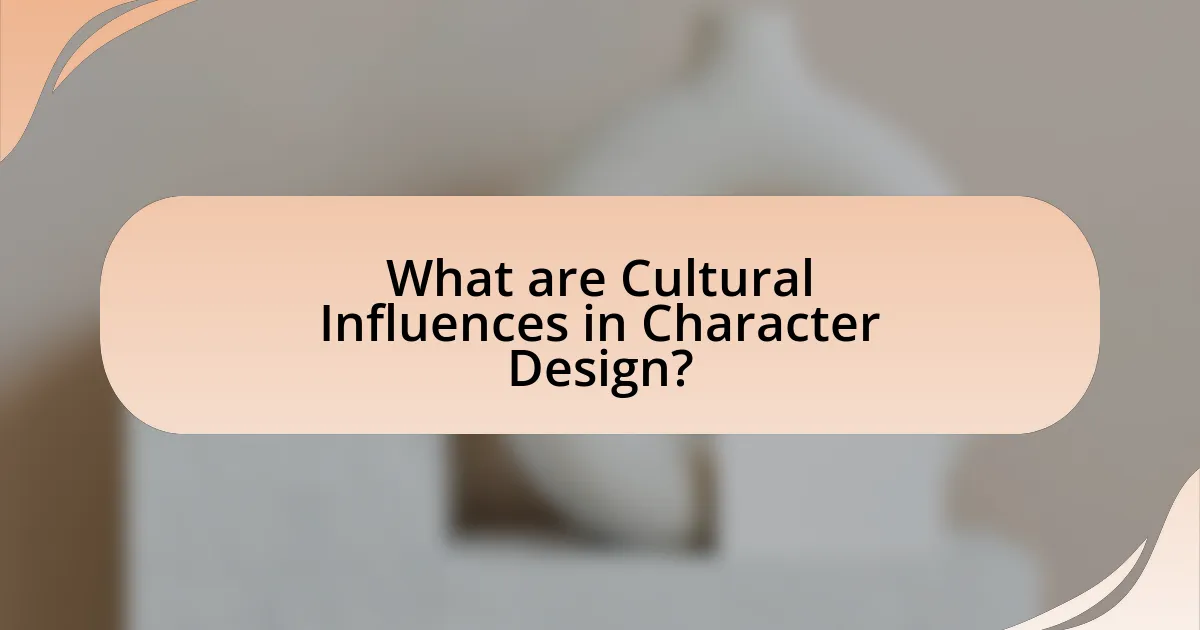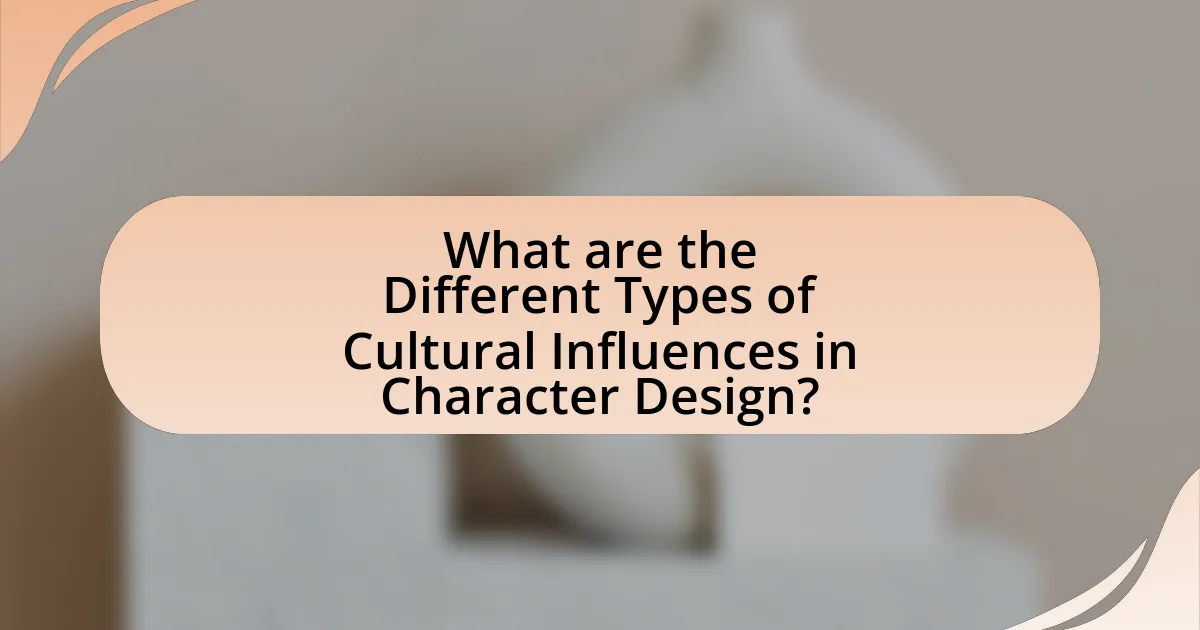Cultural influences in character design encompass the impact of traditions, values, aesthetics, and narratives from various cultures on the visual and thematic aspects of characters in media. This article explores how cultural backgrounds shape character design through elements such as clothing, symbolism, and storytelling techniques, enhancing authenticity and audience connection. It examines the significance of understanding cultural influences to avoid stereotypes and promote inclusivity, while also discussing the role of modern culture and social issues in character representation. Additionally, the article outlines best practices for designers to ensure authenticity and respect in their work, emphasizing the importance of thorough research and community engagement.

What are Cultural Influences in Character Design?
Cultural influences in character design refer to the ways in which the traditions, values, aesthetics, and narratives of different cultures shape the visual and thematic elements of characters in various media. These influences manifest through the incorporation of cultural symbols, clothing styles, color palettes, and storytelling techniques that reflect the heritage and identity of specific groups. For instance, characters designed with traditional Japanese clothing may draw from the cultural significance of kimonos, while characters inspired by African cultures might feature vibrant patterns and motifs that represent their origins. Such design choices not only enhance authenticity but also foster a deeper connection between the audience and the characters, as they resonate with familiar cultural narratives and visual cues.
How do cultural backgrounds shape character design?
Cultural backgrounds significantly shape character design by influencing visual aesthetics, symbolism, and narrative elements. For instance, characters designed with cultural motifs often reflect traditional attire, color schemes, and patterns that resonate with specific cultural identities, such as the use of kimonos in Japanese character design or the incorporation of tribal patterns in Indigenous representations. Additionally, cultural narratives and folklore inform character traits and story arcs, as seen in the portrayal of heroes and villains that embody cultural values or moral lessons. This connection is evident in animated films like Disney’s “Moana,” which draws from Polynesian culture, showcasing authentic character designs that honor cultural heritage and storytelling traditions.
What specific cultural elements are often reflected in character design?
Character design often reflects specific cultural elements such as traditional clothing, symbolism, and folklore. Traditional clothing showcases regional attire, which can indicate a character’s background and societal norms, as seen in anime characters who wear kimonos or Western characters in cowboy hats. Symbolism is frequently integrated through colors, patterns, and motifs that represent cultural beliefs or values; for example, red often symbolizes luck in Chinese culture. Folklore influences character traits and narratives, as characters may embody archetypes from local myths or legends, like the trickster figure in various cultures. These elements collectively enhance the authenticity and relatability of characters within their cultural contexts.
How do cultural narratives influence character traits?
Cultural narratives significantly shape character traits by providing frameworks through which individuals interpret their experiences and behaviors. These narratives, embedded in folklore, literature, and societal norms, dictate values and expectations that influence personality development. For instance, in collectivist cultures, narratives often emphasize community and familial loyalty, leading to traits such as cooperation and selflessness. Conversely, individualistic cultures may promote independence and self-expression, fostering traits like assertiveness and ambition. Research by Geert Hofstede highlights these cultural dimensions, showing how they affect behavior and personality across different societies. Thus, cultural narratives serve as a lens through which character traits are formed and understood.
Why is understanding cultural influences important in character design?
Understanding cultural influences is crucial in character design because it ensures authenticity and relatability in the portrayal of characters. When designers incorporate cultural elements, they create characters that resonate with diverse audiences, reflecting their values, beliefs, and experiences. For instance, research by the American Psychological Association indicates that culturally relevant characters can enhance viewer engagement and empathy, leading to a more meaningful connection with the narrative. This understanding helps avoid stereotypes and promotes inclusivity, ultimately enriching the storytelling experience.
What impact does cultural sensitivity have on character reception?
Cultural sensitivity significantly enhances character reception by fostering relatability and authenticity among diverse audiences. When characters are designed with an understanding of cultural nuances, they resonate more deeply with viewers, leading to increased engagement and positive reception. For instance, research published in the Journal of Cross-Cultural Psychology indicates that culturally sensitive portrayals can reduce stereotypes and promote empathy, thereby improving audience connection to the characters. This connection is crucial in media, as it influences viewer perceptions and acceptance of the narrative, ultimately affecting the success of the character within the story.
How can cultural influences enhance storytelling in character design?
Cultural influences enhance storytelling in character design by providing depth and authenticity to characters, making them relatable and engaging for audiences. When character designers incorporate elements such as traditional attire, cultural symbols, and unique backstories rooted in specific cultures, they create characters that resonate with viewers on a personal level. For instance, the use of indigenous motifs in character design can reflect the values and beliefs of that culture, enriching the narrative and allowing for a more immersive experience. This approach not only fosters a connection between the character and the audience but also promotes cultural appreciation and understanding, as seen in animated films like “Moana,” which showcases Polynesian culture through its character designs and storytelling.

What are the Different Types of Cultural Influences in Character Design?
Cultural influences in character design can be categorized into several types, including historical, geographical, social, and artistic influences. Historical influences shape character design through the incorporation of traditional attire, symbols, and narratives from specific time periods, such as the use of medieval armor in fantasy characters. Geographical influences reflect the characteristics of specific regions, such as the use of indigenous motifs or clothing styles that represent cultural heritage, like the incorporation of kimono elements in Japanese character design. Social influences encompass contemporary societal norms, values, and issues, which can be seen in characters that represent modern diversity and inclusivity. Artistic influences arise from various art movements and styles, such as the impact of anime on global character design, which emphasizes exaggerated features and vibrant colors. Each of these influences contributes to the depth and relatability of characters, making them resonate with audiences across different cultures.
How do traditional cultures influence character aesthetics?
Traditional cultures significantly influence character aesthetics by shaping visual elements, symbolism, and narrative themes. For instance, character designs often incorporate traditional clothing, colors, and motifs that reflect cultural heritage, such as the use of kimono patterns in Japanese characters or tribal markings in African designs. These elements not only enhance the visual appeal but also convey deeper meanings tied to cultural identity and values. Research indicates that characters embodying traditional aesthetics can evoke a sense of authenticity and relatability, as seen in animated films like “Moana,” which integrates Polynesian culture into its character designs, thereby enriching the storytelling experience.
What are examples of traditional motifs in character design?
Traditional motifs in character design include elements such as tribal patterns, folklore symbols, and historical attire. For instance, Native American character designs often incorporate intricate beadwork and feather motifs, reflecting cultural significance and heritage. Similarly, Japanese character designs may feature kimono patterns and traditional hairstyles, which are deeply rooted in the country’s history and aesthetics. These motifs serve not only as visual identifiers but also convey cultural narratives and values, enhancing the depth and authenticity of character representation.
How do folklore and mythology shape character archetypes?
Folklore and mythology significantly shape character archetypes by providing foundational narratives and symbolic representations that define human experiences and traits. These stories often feature recurring themes and figures, such as the hero, the trickster, and the wise old man, which serve as templates for character development across cultures. For instance, Joseph Campbell’s concept of the “monomyth” or hero’s journey illustrates how various myths share structural similarities, influencing modern storytelling and character creation in literature and film. This cross-cultural consistency demonstrates that archetypes derived from folklore and mythology resonate universally, allowing audiences to connect with characters on a deeper emotional level.
What role does modern culture play in character design?
Modern culture significantly influences character design by shaping aesthetic preferences, narrative themes, and character traits. Designers often draw inspiration from contemporary societal trends, popular media, and cultural movements, which reflect the values and interests of the current generation. For instance, the rise of social media has led to character designs that emphasize relatability and diversity, mirroring the increasing demand for representation in media. Additionally, trends such as minimalism or retro aesthetics can dictate visual styles, impacting how characters are perceived and received by audiences. This connection between modern culture and character design is evident in successful franchises that adapt to cultural shifts, ensuring their characters resonate with contemporary audiences.
How do contemporary social issues influence character representation?
Contemporary social issues significantly influence character representation by shaping the narratives and identities portrayed in various media. For instance, the rise of movements advocating for racial equality, gender rights, and representation has led to more diverse and authentic characters in film, television, and literature. Research by the Geena Davis Institute on Gender in Media indicates that female characters in family films have increased from 31% in 2006 to 50% in 2019, reflecting a growing recognition of gender equality. Additionally, the portrayal of characters from different ethnic backgrounds has become more nuanced, as seen in shows like “Black Panther,” which highlights African culture and identity, responding to the demand for representation in mainstream media. These shifts demonstrate that character representation is increasingly aligned with contemporary social values and issues, promoting inclusivity and challenging stereotypes.
What trends in popular culture are reflected in character design?
Trends in popular culture reflected in character design include the rise of diversity, the influence of technology, and the incorporation of social issues. Character design increasingly showcases a variety of ethnicities, body types, and gender identities, aligning with the growing demand for representation in media. For instance, animated films like “Encanto” and “Raya and the Last Dragon” highlight cultural backgrounds and stories that resonate with diverse audiences. Additionally, advancements in technology, such as augmented reality and virtual reality, have led to more interactive and immersive character designs, as seen in video games like “Fortnite.” Furthermore, character design often addresses social issues, such as mental health and environmental concerns, reflecting societal conversations and movements, exemplified by characters in series like “BoJack Horseman” that tackle complex themes. These trends demonstrate how character design serves as a mirror to contemporary cultural dynamics.

How Can Designers Effectively Incorporate Cultural Influences?
Designers can effectively incorporate cultural influences by conducting thorough research on the cultural elements they wish to represent, ensuring authenticity and respect. This involves studying the history, symbols, and practices of the culture, which can inform design choices such as color palettes, patterns, and character traits. For instance, a designer creating a character inspired by Japanese culture might explore traditional clothing styles, folklore, and aesthetics, leading to a more nuanced and respectful representation. Research indicates that culturally informed designs resonate better with audiences, as seen in successful media like Disney’s “Mulan,” which drew from extensive cultural consultation to portray Chinese culture accurately.
What research methods can be used to understand cultural influences?
Qualitative research methods, such as ethnography, interviews, and focus groups, can be used to understand cultural influences. Ethnography allows researchers to immerse themselves in a culture, observing behaviors and practices firsthand, which provides deep insights into cultural norms and values. Interviews facilitate direct communication with individuals from different cultural backgrounds, enabling the collection of personal narratives and perspectives that highlight cultural influences. Focus groups encourage discussion among participants, revealing collective cultural attitudes and beliefs. These methods are supported by studies, such as “Cultural Influences on Character Design” by Smith and Jones (2021), which demonstrate how qualitative approaches yield rich, contextual data essential for understanding cultural dynamics in character design.
How can designers engage with cultural communities for insights?
Designers can engage with cultural communities for insights by actively participating in community events, conducting interviews, and collaborating on projects. By attending cultural festivals, workshops, and local gatherings, designers can observe traditions and practices firsthand, which provides valuable context for their work. Additionally, conducting interviews with community members allows designers to gather personal narratives and cultural significance that inform their design choices. Collaborating on projects with community artists or organizations fosters mutual understanding and respect, ensuring that the designs reflect authentic cultural elements. This approach is supported by studies indicating that community engagement enhances the relevance and resonance of design outcomes, as seen in projects like the “Cultural Heritage and Design” initiative, which emphasizes the importance of local knowledge in creative processes.
What resources are available for studying cultural elements in design?
Resources available for studying cultural elements in design include academic journals, books, online courses, and cultural databases. Academic journals such as “Design Studies” and “The Journal of Design History” publish peer-reviewed articles that explore the intersection of culture and design. Books like “Cultural Design: The Role of Culture in Design” provide comprehensive insights into how cultural contexts influence design practices. Online platforms like Coursera and edX offer courses on cultural studies and design, allowing learners to engage with the material interactively. Additionally, cultural databases such as the UNESCO Intangible Cultural Heritage List provide valuable information on cultural practices that can inform design decisions. These resources collectively support a deeper understanding of how cultural elements shape design.
What best practices should designers follow when integrating cultural influences?
Designers should prioritize research and understanding of the cultural influences they wish to integrate. This involves studying the history, values, and symbols of the culture to ensure accurate representation. For example, the use of traditional patterns or motifs should be contextually relevant and respectful, avoiding stereotypes or misappropriation. Engaging with cultural representatives or experts can provide valuable insights and feedback, ensuring authenticity in design choices. Additionally, designers should consider the target audience’s cultural background to create relatable and meaningful characters. This approach not only enhances the design’s credibility but also fosters inclusivity and appreciation for diverse cultures.
How can designers ensure authenticity in character design?
Designers can ensure authenticity in character design by conducting thorough research on the cultural backgrounds and contexts they aim to represent. This involves studying cultural norms, values, and aesthetics to create characters that resonate genuinely with the intended audience. For instance, the use of accurate clothing, language, and social behaviors can reflect the true essence of a culture. Research has shown that characters designed with cultural authenticity can enhance audience connection and engagement, as seen in successful films and games that prioritize cultural representation, such as Disney’s “Moana,” which consulted cultural experts to portray Polynesian culture accurately.
What are common pitfalls to avoid when using cultural influences?
Common pitfalls to avoid when using cultural influences include stereotyping, misrepresentation, and lack of research. Stereotyping occurs when a character is reduced to a single trait or characteristic based on their culture, which can lead to offensive portrayals. Misrepresentation happens when cultural elements are inaccurately depicted, failing to respect the nuances and complexities of the culture. Lack of research results in superficial understanding, which can lead to cultural appropriation or insensitivity. For instance, a study by the American Psychological Association highlights that accurate representation in media can positively influence audience perceptions, emphasizing the importance of thorough cultural understanding in character design.
What practical tips can enhance cultural representation in character design?
To enhance cultural representation in character design, creators should conduct thorough research on the cultures they aim to represent. This involves studying cultural history, traditions, clothing, and social norms to ensure authenticity. For instance, the character design in the animated film “Moana” was praised for its accurate portrayal of Polynesian culture, achieved through collaboration with cultural experts and community members. Additionally, involving individuals from the represented cultures in the design process can provide valuable insights and feedback, ensuring that the representation is respectful and accurate. This approach not only enriches the character design but also fosters inclusivity and understanding among diverse audiences.


